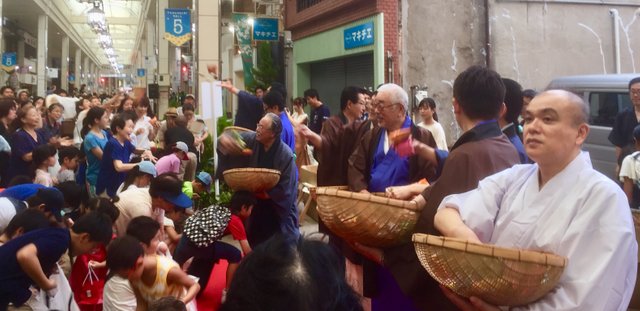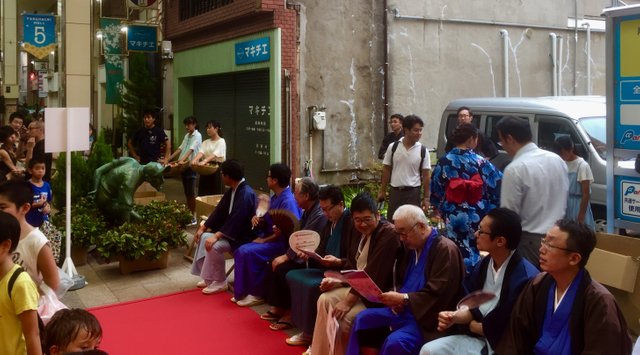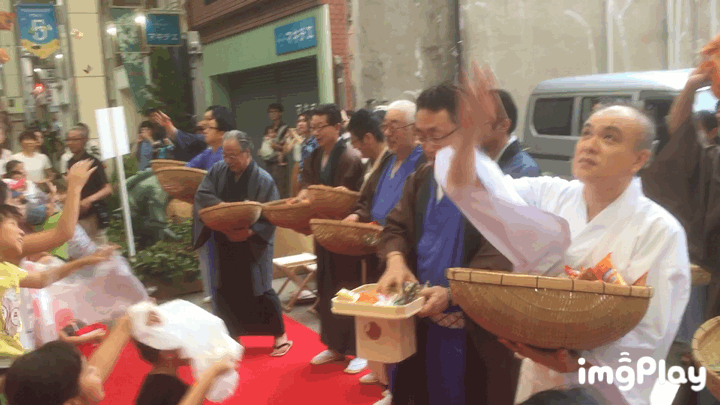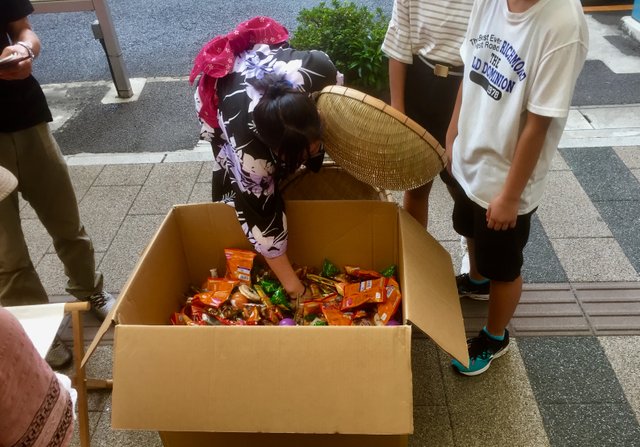Explore everyday life in Japan

It began with a relatively empty arcade and a few red carpets placed on the ground. It was clear to anyone passing through the area that, soon, something would happen.
Slowly, curious passersby began to stop and gather. Three crowds of expectant people formed around the three red carpets that were evenly spaced across the length of the arcade. No one, however seemed to know what exactly was going to take place.
As they waited, stools were brought out before the steadily growing crowds and were placed in single rows on the rear edges of the carpets. The stools seemed to suggest that a performance of some kind might soon take place.

Then men with megaphones began giving directions not to stand on the sides of the red carpets, and large cardboard boxes were carried from a van that had been parked a little further off near the arcade’s entrance.
Not long after, a group of girls dressed in kimono came along and took up positions behind the stools. Then some well-to-do and important looking men filed in front of the girls and stood somewhat confusedly awaiting directions. A few of the kimono-clad girls opened the cardboard boxes revealing a variety of snacks and candy, and, suddenly, the mood of the three small crowds changed. Everyone became excited.
A mochi maki event! Or something similar, at least.

Mochi maki is an event that isn’t very common in Japan anymore. In nine years, this is only the second time that I’ve ever seen one, and the first time that I’ve seen one take place in public. The first mochi maki that I attended was held at a private house. There, scaffolding was erected, and the men of the house climbed to the top deck and rained rice crackers, chocolates, candy bars, bags of potato chips and much more down onto the gathered spectators.
The family that held the mochi maki owned a construction company. To celebrate their success, they invited all of their past employees and customers out to an annual barbecue where they carried on this slowly disappearing tradition, a tradition which used to be held after the pole beam had been raised and the roof put in place on new houses and buildings.

How common an event mochi maki used to be, I can’t say. Traditionally, though, mochi was apparently thrown down from the newly built rooftops into the gathered crowds. The people in the crowds would then, as they do today, get a little wild while doing their best to pick up and receive as much mochi as they could.
As I’ve said, I don’t know how common mochi maki used to be, but it most certainly isn’t a part of everyday life in Japan these days. What is, however, typical of life over here, is that you never know exactly what kind of event you may happen upon while taking a typical family walk through an arcade or around town.
This is an ongoing series that will explore various aspects of daily life in Japan. My hope is that this series will not only reveal to its followers, image by image, what Japan looks like, but that it will also inform its followers about unique Japanese items and various cultural and societal practices. If you are interested in getting regular updates about life in Japan, please consider following me at @boxcarblue. If you have any questions about life in Japan, please don’t hesitate to ask. I will do my best to answer all of your questions.
Nice post i like it 😍😍
Downvoting a post can decrease pending rewards and make it less visible. Common reasons:
Submit
Thanks!
Downvoting a post can decrease pending rewards and make it less visible. Common reasons:
Submit
Can you appreciate me more than my frnd
Downvoting a post can decrease pending rewards and make it less visible. Common reasons:
Submit
How much does your friend appreciate you?
Downvoting a post can decrease pending rewards and make it less visible. Common reasons:
Submit
More than you
Downvoting a post can decrease pending rewards and make it less visible. Common reasons:
Submit
How do you know?
Downvoting a post can decrease pending rewards and make it less visible. Common reasons:
Submit
Hello! Thank you for this insight in Japan. I just don't understand fully or maybe I didn't read accurate enough.
They throw around the candy, is that the event? What are the red carpets and the chairs for? Is there a ceremony or ritual?
Downvoting a post can decrease pending rewards and make it less visible. Common reasons:
Submit
Well, to be honest, I don’t fully understand this ceremony either. My previous encounter with it and prior knowledge of it has been related to architecture and new buildings. When the roof was put on a new building, mochi was thrown down from the roof. At some point, mochi was replaced with a variety of candy and snack foods.
A similar type of ceremony is apparently also related to Shintoism and sometimes held at shrines, though I’ve never seen one held at a shrine. I have no idea what the meaning of the red carpets is, but I assume that it is connected to Shintoism. I’ll see what I can find out.
Mostly, the meaning of this post is that you never know what you may encounter in Japan in any given day.
Downvoting a post can decrease pending rewards and make it less visible. Common reasons:
Submit
The children are delighted.
Posted using Partiko iOS
Downvoting a post can decrease pending rewards and make it less visible. Common reasons:
Submit
Yes, they were. And the four old women standing next to me who were all in their 70s or 80s were even more excited. 😆
Downvoting a post can decrease pending rewards and make it less visible. Common reasons:
Submit
Almost like a reverse Halloween where you dont have to seek the good stuff, the throw it to you!
Downvoting a post can decrease pending rewards and make it less visible. Common reasons:
Submit
Yeah, you can definitely compare it to Halloween. I tend to think of it as a big parade without the procession. The funny thing is that the adults, especially the seniors, get the most into this.
Downvoting a post can decrease pending rewards and make it less visible. Common reasons:
Submit